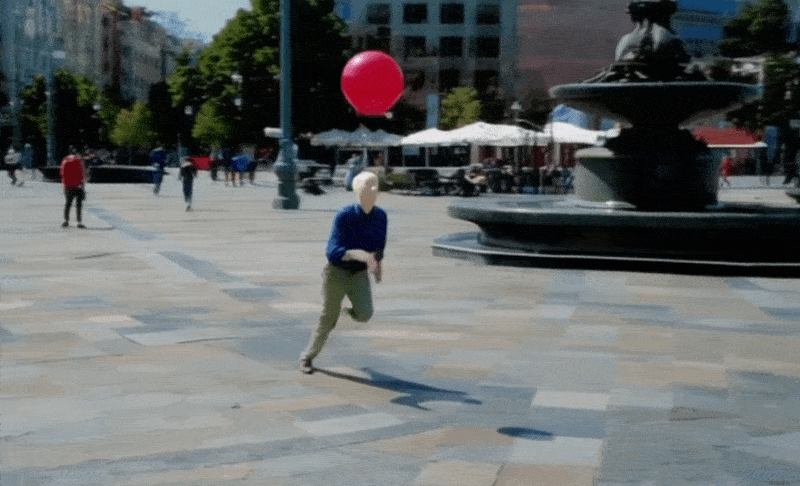OpenAI’s video generation tool Sora took the AI community by surprise in February with fluid, realistic video that seems miles ahead of competitors. But the carefully stage-managed debut left out a lot of details — details that have been filled in by a filmmaker given early access to create a short using Sora.
Shy Kids is a digital production team based in Toronto that was picked by OpenAI as one of a few to produce short films essentially for OpenAI promotional purposes, though they were given considerable creative freedom in creating “air head.” In an interview with visual effects news outlet fxguide, post-production artist Patrick Cederberg described “actually using Sora” as part of his work.
Perhaps the most important takeaway for most is simply this: While OpenAI’s post highlighting the shorts lets the reader assume they more or less emerged fully formed from Sora, the reality is that these were professional productions, complete with robust storyboarding, editing, color correction, and post work like rotoscoping and VFX. Just as Apple says “shot on iPhone” but doesn’t show the studio setup, professional lighting, and color work after the fact, the Sora post only talks about what it lets people do, not how they actually did it.
Cederberg’s interview is interesting and quite non-technical, so if you’re interested at all, head over to fxguide and read it. But here are some interesting nuggets about using Sora that tell us that, as impressive as it is, the model is perhaps less of a giant leap forward than we thought.
Control is still the thing that is the most desirable and also the most elusive at this point. … The closest we could get was just being hyper-descriptive in our prompts. Explaining wardrobe for characters, as well as the type of balloon, was our way around consistency because shot to shot / generation to generation, there isn’t the feature set in place yet for full control over consistency.
In other words, matters that are simple in traditional filmmaking, like choosing the color of a character’s clothing, take elaborate workarounds and checks in a generative system, because each shot is created independent of the others. That could obviously change, but it is certainly much more laborious at the moment.
Sora outputs had to be watched for unwanted elements as well: Cederberg described how the model would routinely generate a face on the balloon that the main character has for a head, or a string hanging down the front. These had to be removed in post, another time-consuming process, if they couldn’t get the prompt to exclude them.
Precise timing and movements of characters or the camera aren’t really possible: “There’s a little bit of temporal control about where these different actions happen in the actual generation, but it’s not precise … it’s kind of a shot in the dark,” said Cederberg.
For example, timing a gesture like a wave is a very approximate, suggestion-driven process, unlike manual animations. And a shot like a pan upward on the character’s body may or may not reflect what the filmmaker wants — so the team in this case rendered a shot composed in portrait orientation and did a crop pan in post. The generated clips were also often in slow motion for no particular reason.

Example of a shot as it came out of Sora and how it ended up in the short. Image Credits: Shy Kids
In fact, using the everyday language of filmmaking, like “panning right” or “tracking shot” were inconsistent in general, Cederberg said, which the team found pretty surprising.
“The researchers, before they approached artists to play with the tool, hadn’t really been thinking like filmmakers,” he said.
As a result, the team did hundreds of generations, each 10 to 20 seconds, and ended up using only a handful. Cederberg estimated the ratio at 300:1 — but of course we would probably all be surprised at the ratio on an ordinary shoot.
The team actually did a little behind-the-scenes video explaining some of the issues they ran into, if you’re curious. Like a lot of AI-adjacent content, the comments are pretty critical of the whole endeavor — though not quite as vituperative as the AI-assisted ad we saw pilloried recently.
The last interesting wrinkle pertains to copyright: If you ask Sora to give you a “Star Wars” clip, it will refuse. And if you try to get around it with “robed man with a laser sword on a retro-futuristic spaceship,” it will also refuse, as by some mechanism it recognizes what you’re trying to do. It also refused to do an “Aronofsky type shot” or a “Hitchcock zoom.”
On one hand, it makes perfect sense. But it does prompt the question: If Sora knows what these are, does that mean the model was trained on that content, the better to recognize that it is infringing? OpenAI, which keeps its training data cards close to the vest — to the point of absurdity, as with CTO Mira Murati’s interview with Joanna Stern — will almost certainly never tell us.
As for Sora and its use in filmmaking, it’s clearly a powerful and useful tool in its place, but its place is not “creating films out of whole cloth.” Yet. As another villain once famously said, “that comes later.”

